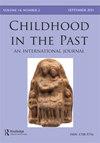罗马世界的婴儿期和最早的童年时间的碎片
IF 0.5
Q3 ANTHROPOLOGY
引用次数: 10
摘要
过去的亲情和悲伤。Rebay Salisbury的章节还提供了许多青铜时代奥地利的此类墓葬的例子,更具体地关注母亲/孩子的关系。此外,她还强调了一些真正引人注目的多次埋葬,包括一具男子的尸体覆盖着三个孩子(DNA结果尚待确定),以及两个2岁和6岁的孩子(可能是兄弟姐妹)的感人拥抱埋葬。不可避免的是,许多章节侧重于埋葬证据,但也有一些章节包含了从文本来源收集的信息,以帮助解释。例如,Zoega关于冰岛北部早期基督教家庭墓地的章节展示了三代家庭是如何常见的。这种生活距离对于代际知识、经验和家庭认同的传播具有重要意义。这些墓地为冰岛传奇增添了另一个维度,冰岛传奇往往呈现出一种老年的负面形象,权力和地位都在下降。它提醒我们,权力有不同的形式。加洛关于青铜时代晚期爱琴海的米诺斯和迈锡尼社会的章节是少数关注材料而非骨骼证据的章节之一。她为儿童和老一辈提供了丰富的相关证据,包括对老年妇女在仪式治疗、儿童保育和葬礼准备中发挥积极作用的艺术描绘。勒罗伊及其同事的其他章节研究了法国新石器时代埋葬环境中5岁以下儿童的代表性不足和偶尔完全缺席的情况。德纳姆及其同事强调了火化的人类遗骸和档案记录对了解挪威青铜和铁器时代与年龄相关的埋葬实践的价值。考虑到整本书对骨骼遗骸的关注,Maaranen和Buckberry的最后一章恰当地解决了骨骼年龄估计的棘手问题,以及当前技术低估老年人死亡年龄的趋势,从而导致他们的隐形。总的来说,这是一本优秀的书,我强烈推荐它。我唯一的小批评是,引言感觉有点草率,本可以在当前的理论和方法论方法方面做得更多。本书还将受益于最后一章,以突出关键主题和未来方向。这本书展示了探索过去至今难以捉摸的代际关系的创新和创造性方法。我将在加洛(70岁)精彩的一章的结尾留给你一句中肯的话:“没有一只脚太小或太老,不能在这个世界上留下印记,无论是过去还是现在”。本文章由计算机程序翻译,如有差异,请以英文原文为准。
Infancy and Earliest Childhood in the Roman World. ‘A Fragment of Time’
nants of kinship and grief in the past. Rebay-Salisbury’s chapter also supplies numerous examples of such burials from Bronze Age Austria, with a more specific focus on mother/ child relationships. In addition, she highlights some truly remarkable multiple interments, including the body of a man overlaying three children (DNA results are pending), and the touching burial of two children aged 2 and 6 years, possibly siblings, in an embrace. Inevitably, many of the chapters focus on burial evidence, but a number also incorporate information gleaned from textual sources to aid interpretations. For example, Zoega’s chapter on early Christian household cemeteries from Northern Iceland shows how three-generation households were common. The importance of this lived proximity for the transmission of inter-generational knowledge, experience and familial identity was significant. These cemeteries add another dimension to the Icelandic Sagas which more often present a negative image of old age, with a diminution of power and status. It reminds us that power has different forms. Gallou’s chapter on Minoan and Mycenaean societies of the late Bronze Age Aegean is one of the few that focuses on material rather than skeletal evidence. She provides a rich array of relevant evidence for children and older generations, including artistic depictions of elderly women playing active roles in ritual healing, as well as childcare and funerary preparations. Other chapters from Le Roy and colleagues examine the under-representation and occasional complete absence of children under 5 years from Neolithic burial contexts in France. Denham and colleagues highlight the value of cremated human remains and archival records for understanding age-related burial practice in the Bronze and Iron Age in Norway. Given the focus on skeletal remains throughout the book, it is apt that the final chapter by Maaranen and Buckberry addresses the thorny problem of skeletal age estimation and the tendency for current techniques to under-estimate age-at-death of older people and thus contribute to their invisibility. Overall, this is an excellent book and I highly recommend it. My only minor criticism is that the introduction felt a bit cursory and could have done more to set the scene in terms of current theoretical and methodological approaches to the life course. The book would also have benefited from a concluding chapter to highlight key themes and future directions. The book showcases innovative and creative approaches for exploring hitherto elusive intergenerational relationships in the past. I will leave you with Gallou’s (70) pertinent observation at the end of her excellent chapter: ‘There is no foot too small or too old that it cannot leave an imprint on this world, past and present’.
求助全文
通过发布文献求助,成功后即可免费获取论文全文。
去求助
来源期刊

Childhood in the Past
Social Sciences-Anthropology
CiteScore
0.90
自引率
0.00%
发文量
16
期刊介绍:
Childhood in the Past provides a peer-reviewed, interdisciplinary, international forum for the publication of research into all aspects of children and childhood in the past, which transcends conventional intellectual, disciplinary, geographical and chronological boundaries. The editor welcomes offers of papers from any field of study which can further knowledge and understanding of the nature and experience of childhood in the past.
 求助内容:
求助内容: 应助结果提醒方式:
应助结果提醒方式:


